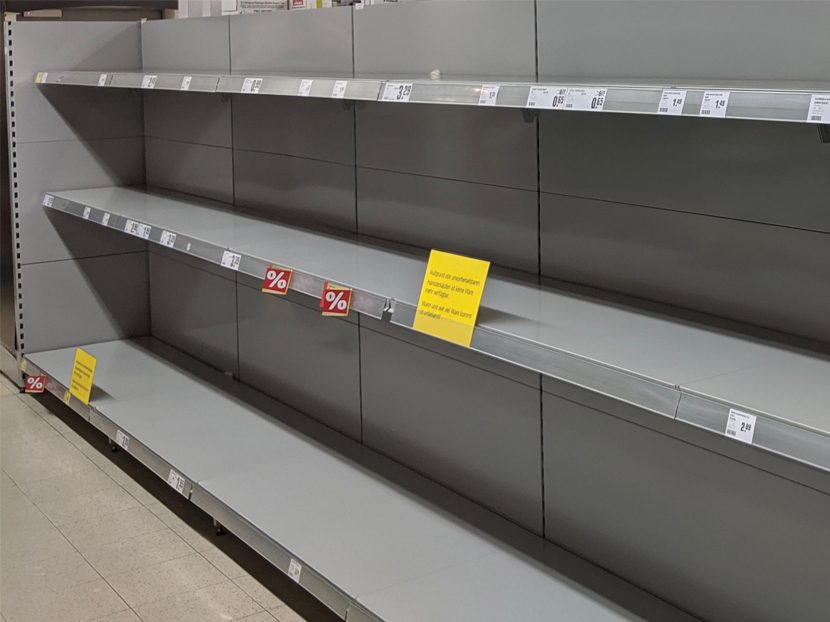Safety Stock: Love It or Hate It? A Rebuttal
There’s a better way to recognize customer demand signals within your distribution network.

An August article in the Wall Street Journal titled, “Why Are There Still Not Enough Paper Towels?” was extremely thought-provoking. It suggested that supply chains need to rethink how we view safety stock. Then it asked this question: Should we scrap lean, just-in-time supply chains in light of industry experience in a COVID-19-type environment?
Frankly, it seemed to me an old answer to an old question: Do we throw more safety stock at it?
Of course, the issue at hand was not just the familiar stories about paper towels, toilet paper, baking flour and cleaning products, etc. People weren’t necessarily using more toilet paper or even eating more bread. Demand had shifted to panic buying and hoarding, and different put-ups or configurations of product being purchased. In real time, historical demand patterns were being changed! Let’s not lose track of that.
Sure, there was no toilet paper in grocery stores, but somewhere, warehouses were bulging with institutional toilet paper rolls. They’re made on different production lines that are slow — costly — to change over to consumer versions.
And what about those 50-pound sacks of bread flour in warehouses for industrial bakeries (some of which had to close down, at least for a time, because of COVID-19), while Mom or Dad couldn’t buy any flour to bake cookies for the kids? This is what’s now being called the “perfect storm.”
So, there’s an awful lot to unpack here, and we need to focus on the right things.
Let’s Not Throw Out
Lean Thinking
According to the gospel of Lean, eliminate waste (cost) from every aspect of production, storage and distribution. Nothing wrong with that, is there?
It’ll take more than a WSJ article to get to the bottom of this, the symptoms vs. actual root causes. Those of us familiar with lean concepts are asking if the “5 Whys” are sufficient. The memory our supply chain networks have relied upon to anticipate and resolve supply chain problems has been severely damaged, maybe even gone for some. It may take a while before it returns.
However, I don’t think we necessarily need to disrupt any lean wisdom here; rather, be wiser and reinforce it. Why? We can do little to forecast a perfect storm, particularly the way this one came at us. It was beyond our experience or imagination.
Solutions have been available for some time yet not sufficiently adopted to mitigate our ability to become more flexible in our supply chain planning, how we recognize changes in demand patterns and then the reaction/forward-planning subsequently required.
And that goes for both manufacturing vendors/suppliers, who should not be just sources of better pricing and payment terms for short-term savings, and wholesale distribution companies, which should be expecting more from vendors to do their appropriate planning mitigation while adopting their own reaction and planning mechanisms.
Most people intuitively recognize what we’re talking about here, yet they find them counterintuitive when they read or hear of the methodologies and solutions. I’ve always thought it’s a certain DNA that’s been ingrained in us!
Maybe you won’t be able to address all the hair-raising scenarios you’ve read and heard about, particularly the suddenness of it all. You can surely address how to march more quickly to the customer’s drumbeat, not just throw more safety stock at it. It’s an old, worn-out mantra that has driven some companies to maintain safety stock levels of up to 50 percent of their total inventory cost while impacting their financial performance.
And, by the way, I suggest you could march to this drumbeat with the robust enterprise system tools you probably already possess!
Again, this is not just about safety stock; this is not just about some perceived frailties of just-in-time methodology. It is about a better way to recognize customer demand signals within each company’s distribution network — branch by branch — and at a central distribution center (if you have one).
It is about a sensing mechanism that recognizes those demand signals. And your suppliers need to be connected to this demand signal eco-system. (I anticipate this will be the subject of another article.)
A Pulling Inventory Strategy
Now Figure 1 is picture truly worth a thousand words! Notice the right side? Average inventory is lower. Inventory peaks are lower. The inventory lows on the right side are higher than those on the left side. Why these results? When inventory replenishment occurs more frequently to start with, and with a more continuous flow of inventory, shortages can be mitigated (maintaining or improving service levels).
So why not turn to a strategy of focusing on the significant inventory drivers below? Our new strategy’s overriding difference is that we are now pulling inventory between the supplier, the distribution center and branches, rather than pushing it based on some suspect/unreliable demand pattern.
1. Increasing replenishment order frequency;
2. Using more actual demand to drive immediate replenishment needs;
3. Shortening actual replenishment lead times;
4. Reducing re-order sizes; and
5. Mitigating safety stock needs (the results from No. 1 through No. 4).
Think about it; it’s not necessarily high-tech. The first four steps foster replenishment cycles that will occur more often, plain and simple. Minimized safety stock, No. 5, is the result and a significant and added benefit — less vulnerability to demand variance.
Replenishment More Aligned with Actual Demand
This strategy change results in four significant outcomes:
1. A continuous flow of product, rather than those high peaks you see on the left side of Figure 1.
2. Improved forecast demand accuracy; now there is more reliance on what customers actually have bought during the shortened replenishment cycle.
3. Safety stock is minimized because you are reacting to actual demand. It’s more like just-in-time, not just-in-case.
4. The opportunity to foster demand signals becomes more of a reality.Katherine Ross, managing director of Stone Cliff Consulting, notes in a Sept. 29 SupplyChainDive article that some people believe we are in the “eye of the storm,” where “savvy supply chain leaders are rebalancing their organization’s skillsets for the ‘next normal,’ before the winds pick back up.” With no historical guidelines, a “company’s speed of sensing and reacting to new demand signals will drive the top line” for the coming months.
I don’t disagree, but by the time you read this article, probably in December 2020, I hope we’ll know!





